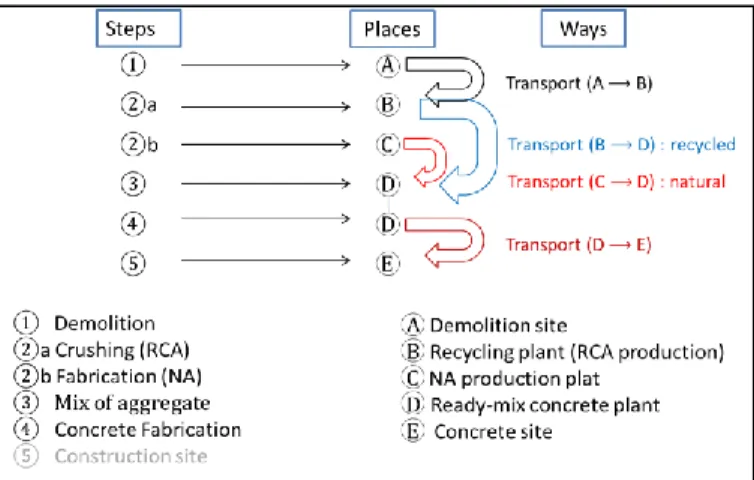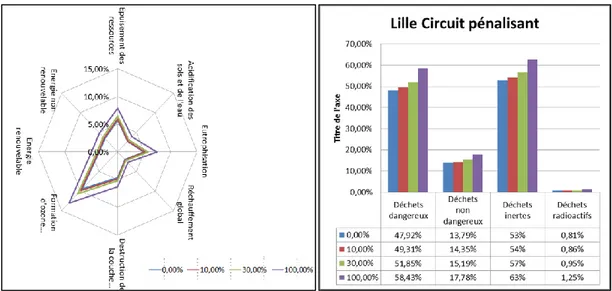HAL Id: hal-02147729
https://hal.archives-ouvertes.fr/hal-02147729
Submitted on 21 Aug 2019HAL is a multi-disciplinary open access archive for the deposit and dissemination of sci-entific research documents, whether they are pub-lished or not. The documents may come from teaching and research institutions in France or abroad, or from public or private research centers.
L’archive ouverte pluridisciplinaire HAL, est destinée au dépôt et à la diffusion de documents scientifiques de niveau recherche, publiés ou non, émanant des établissements d’enseignement et de recherche français ou étrangers, des laboratoires publics ou privés.
Influence of materials composition and transportation
tours on life cycle assessment of recycled aggregate
concrete
Sandrine Braymand, Adélaïde Feraille Fresnet, Nicolas Serres, Francoise
Feugeas
To cite this version:
Sandrine Braymand, Adélaïde Feraille Fresnet, Nicolas Serres, Francoise Feugeas. Influence of ma-terials composition and transportation tours on life cycle assessment of recycled aggregate concrete. HISER International Conference (2017-06-21, 2017-06-23: Delft, The Netherlands), Jun 2017, Delft, Netherlands. �hal-02147729�
INFLUENCE OF MATERIALS COMPOSITION AND TRANSPORTATION TOURS ON LIFE CYCLE ASSESSMENT OF RECYCLED AGGREGATE
CONCRETE
Sandrine Braymand1, Adélaïde Feraille2, Nicolas serres3, Françoise Feugeas4
1 ICube, Univ. de Strasbourg, CNRS, 72 Route du Rhin, Illkirch , France, Phone
(+33) 663 15 82 74, s.braymand@unistra.fr
2 Navier laboratory, ENPC, Paris Est university, Paris, France,
adelaide.feraille@enpc.fr
3 ICube, INSA Strasbourg, CNRS, 24 bd de la Victoire, Strasbourg, France,
nicoals.serres@insa-strasbourg.fr
4 ICube, INSA Strasbourg, CNRS, 24 bd de la Victoire, Strasbourg, France,
francoise.feugeas@insa-strasbourg.fr
ABSTRACT
In a context of incitation to the waste recovery as recycled aggregates to be re-introduced into new concrete, this paper aims to compare the environmental impacts related to the composition of concrete to ones due to the transportation of the recycled aggregates, issued from demolition wastes, by implementing a life cycle assessment (LCA). This study is linked to the RECYBETON French Research Project involving public research laboratories, institutes and private companies.
Life cycle assessment (LCA) of recycled aggregates concrete (RAC) in comparison with a natural aggregates concrete (NAC) are realized. The study focuses first on the influence of the composition parameters of the concrete, in particular the content of recycled aggregates, the cement dosage and type, and the water content. The use of recycled aggregates in concrete formulations increases environmental impacts at different levels. This result is due to the increase of the cement content in the samples, because a standardized mechanical strength is required. Then, optimized formulations of concrete with close mechanical strengths are performed in order to obtain the same cement content (CEM 1) and the same efficient water. Four substitution rates are tested: 0, 10%, 30% and 100%. Moreover, in order to take into account impact distance, several transport distances of natural and recycled aggregates are proposed, it allows to study the integrated management of demolition waste streams in several areas.
Key words: Demolition Waste; Life Cycle Assessment (LCA); Recycled aggregate; Concrete; Transportation.
1. INTRODUCTION
Construction and demolition waste is one of the most important waste streams in developed countries [NPV 13, COR 11]. Wastes management encourages their recovery as recycled aggregates for concrete. The eco-friendly nature of these concrete composed of recycled concrete aggregates is studied here by a calculation of
Life Cycle Assessment (LCA) [SER 16, GOM 13] of Recycled Aggregates Concrete (RAC) and Natural Aggregates Concrete (NAC). The LCA results are presented according to the environmental impact assessment method described in EN 15804 [AFN 14]. The final aim of RECYBETON project, which supports this study, is to modify the recommendations in order to promote the complete recycling of concrete in a circular economy [REC 12].
2. EXPERIMENTAL METHODS AND RESULTS
In a first part, the study focuses on the influence of the composition parameters of the concrete, in particular the content of recycled or natural aggregates, the cement dosage and the water content. For these concrete, the objective is to ensure same compressive strengths for RAC and NAC (C35/45). It is shown that the use of recycled aggregates in concrete formulations increases environmental impacts at different levels. This result seems due to the increase of the cement content in the samples tested on this first part, because a standardized mechanical strength was required. For this part, short circuits for the transport of aggregates are taken as working hypothesis.
Then optimized formulations of concrete using superplasticizers are performed in order to obtain the same cement content for close mechanical strengths (29-33 MPa) [DEO 15]. Indeed, in order to take into account only the impact distance and substitution rate in this comparative study, concrete compositions with constant formulation between natural aggregate and recycled aggregate (W/C, cement dosage, minimum strength) are studied. Four substitution rates are tested: 0, 10%, 30% and 100% (see Table 1). Several transport distances of natural and recycled aggregates are proposed . These distances are calculated for several towns and for several circuits in order to study the integrated management of demolition waste streams in several areas. One of these circuits is illustrated on Figure 1. In this way, several transport distances of natural aggregates and recycled aggregates are proposed. These combination of circuit, town and substitution rates leads to analyzing 80 LCA.
Table 1. Concrete compositions.
0% RCA 10% RCA 30% RCA 100% RCA
Efficient Water(kg) 169 169 169 169
Eff Water + absorption Water 182 192 213 284
Cement (kg) 260 260 260 260
Natural Aggregate (NA)l (kg) 1906 1715 1334 -
Recycled Concrete Aggregate (RCA) (kg) - 153 458 1527
Figure 1. Example of Transport Circuit.
Before quantifying influences of substitution rate in function of transport distances, it was necessary to calculate the LCA of referent concrete established without transportation of aggregates. No significant differences are observed for recycled aggregates concrete and natural aggregate concrete as shown Figure 2.
Figure 2. Influence of substitution rate for referent concrete
The results of benchmarking of materials composition influence and transportation influence on LCA of RAC carried out are presented for a negative circuit and town (see Figure 3 LCA of transport vs LCA of total process). Excepted for wastes indicators, using recycled concrete aggregates in substitution of natural aggregates doesn’t changes significantly LCA.
3. CONCLUSION
Influence of material composition of recycled aggregate concrete on LCA is conditioned by the cement content cement type. If same cement content is used, using recycled aggregate in substitution of natural aggregate doesn’t change significantly LCA for the majority of indicators. When demolition recycling plants are located in town suburb, influence of aggregates transportation on LCA of RCA is limited, not upper than 10%, excepted for waste indicators. LCA is not the methodology to be used to confirm the eco-friendly nature of Recycled Aggregate Concretes. The two
eco-friendly criteria for RAC are the aggregate resource preservation and the non-storage of the waste upstream, these criteria are not evaluated effectively by LCA.
Figure 3. Transport contribution vs total LCA REFERENCES
[VAN 13] VANDECASTEELE C., HEYNEN J., GOUMANS H., Materials Recycling in Construction: A Review of the Last 2 Decades Illustrated by the WASCON Conferences, Waste Biomass Valorization, Vol.4, 2013, p. 695–701. [COR 11] CORONADO M., DOSAL E., COZ A., VIGURI J.R., ANDRÉS A., Estimation of Construction and Demolition Waste Generation and Multicriteria Analysis of C&DW Management Alternatives: A Case Study in Spain, Waste Biomass Valorization, Vol.2, 2011, p. 209–225.
[SER 16] SERRES N., BRAYMAND S., FEUGEAS F., Environmental evaluation of concrete made from recycled concrete aggregate implementing life cycle assessment, J. Build. Eng., Vol. 5, 2016, p. 24–33.
[AFN 14] AFNOR, NF EN 15804+A1, Contribution des ouvrages de construction au développement durable - Déclarations environnementales sur les produits - Règles régissant les catégories de produits de construction, 2014.
[REC 12] French National Project RECYBETON, http://www.pnrecybeton.fr/. [GOM 13] GOMES F, BRIÈRE R, FERAILLE A, HABERT G, Adaptation of environmental data to national and sectorial context: application for reinforcing steel sold on the French market, The Int. J. of Life Cycle Assessment, Vol. 18, Issue 5, 2013, p. 926-938
[DEO 15] DEODONNE K., Etude des propriétés physicochimiques des bétons de granulat recyclés et de leur impact environnemental, Thèse de doctorat, Université de Strasbourg, 2015.


